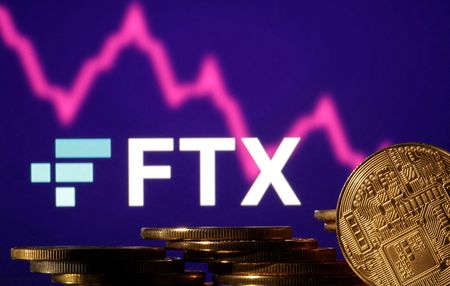By Dietrich Knauth
(Reuters) – Crypto exchange FTX filed for Chapter 11 bankruptcy protection in the United States on Friday following its precipitous collapse, saying it could owe money to more than 1 million creditors. Here is what likely awaits in the case:
WHERE DO THINGS STAND IN FTX’S BANKRUPTCY CASE?
FTX had an unusually slow start to its bankruptcy, taking nearly a week to file “first-day” papers that describe the company’s debts and how it ended up in bankruptcy.
The reason for that delay became apparent when FTX’s new CEO, John Ray, described the “unprecedented” chaos at the company in court filings on Nov. 17.
“Never in my career have I seen such a complete failure of corporate controls and such a complete absence of trustworthy financial information as occurred here,” said Ray, a restructuring expert with decades of experience who oversaw the multiyear liquidation of energy firm Enron after its collapse in 2001.
Ray, who took over as CEO when FTX filed for bankruptcy protection, said his immediate priorities are locating and securing assets, investigating claims against insiders like former FTX CEO Sam Bankman-Fried, and cooperating with dozens of regulatory investigations in the United States and abroad.
The dire situation at FTX will make it difficult for the company to borrow new money that could be used to reorganize the company or buy time for a sale, according to University of Pennsylvania law professor David Skeel.
HAS FTX BEEN ABLE TO SECURE CUSTOMER ASSETS?
Bankman-Fried secretly used $10 billion in customer funds to prop up his trading company Alameda Research, and at least $1 billion of those deposits have vanished, sources have told Reuters.
Under its new management, FTX has located and secured $740 million in cryptocurrency, which represents “only a fraction” of the digital assets the company will seek to recoup for creditors.
Bankman-Fried claimed in 2021 that customers held $15 billion on FTX’s platform, but FTX has not verified that amount. FTX did not record customer deposits as balance sheet assets, and balance sheets prepared under Bankman-Fried’s leadership cannot necessarily be trusted, Ray wrote.
FTX is attempting to recover additional assets, including $372 million that was withdrawn without authorization on the day of the company’s bankruptcy filing. FTX believes the company’s co-founders and other insiders may have further information about additional crypto wallets that are unknown to the company’s restructuring team, according to the Nov. 17 filing.
WILL CUSTOMERS GET THEIR MONEY BACK?
Unlike deposits at banks, customer accounts at crypto platforms like FTX are not protected by the Federal Deposit Insurance Corporation. The U.S. government will not step in to cover customer deposits as they would in a traditional bank failure, so customers will have to rely on the bankruptcy process.
A Chapter 11 case halts attempts to recoup assets from a bankrupt company, so customers will have to wait for the bankruptcy court to determine how much, if anything, they will get back. One of the key questions for the court will be whether customers own the cryptocurrency they deposited or whether it is FTX’s property.
There is very little legal precedent for that question. In recent crypto bankruptcies, Celsius Network and Voyager Digital both claimed they owned all crypto held on their platforms. That means the crypto would be pooled with all of the bankrupt company’s assets and divided to pay all creditors. In that scenario, customers would have what are known as unsecured claims that would be relatively low in priority.
If customers are found to own the crypto, they stand a greater chance of recovering a larger portion of their deposits. But the recovery will still depend on how much FTX owes and what assets it has left.
Bankruptcy judges have so far accepted Celsius and Voyager’s arguments, although that could be subject to future court battles, said James Van Horn, a bankruptcy attorney in Washington, D.C.
WHAT ABOUT FTX CUSTOMERS WHO WITHDREW MONEY FROM FTX?
Customers who withdrew their assets from FTX before its collapse are not necessarily in the clear. The bankruptcy court might authorize FTX to claw back those withdrawals so that there can be a more equal payout for creditors who were unable to make withdrawals. In cases involving fraud, the clawback period can be extended for years.
“It’s risky to feel like you dodged a bullet, because sometimes you didn’t,” Harvard professor Jared Elias said.
WHAT OTHER RISKS DO FTX CUSTOMERS FACE?
The bankruptcy might result in the publication of FTX customers’ names, email addresses and transaction history.
Bankruptcy depends on transparency – at a minimum, the court needs to know who is owed money, how much they are owed, and how to contact creditors. The courts’ preference for transparency are at odds with crypto customers’ expectations of anonymity.
(Reporting by Dietrich Knauth in New York; Editing by Alexia Garamfalvi and Matthew Lewis)

